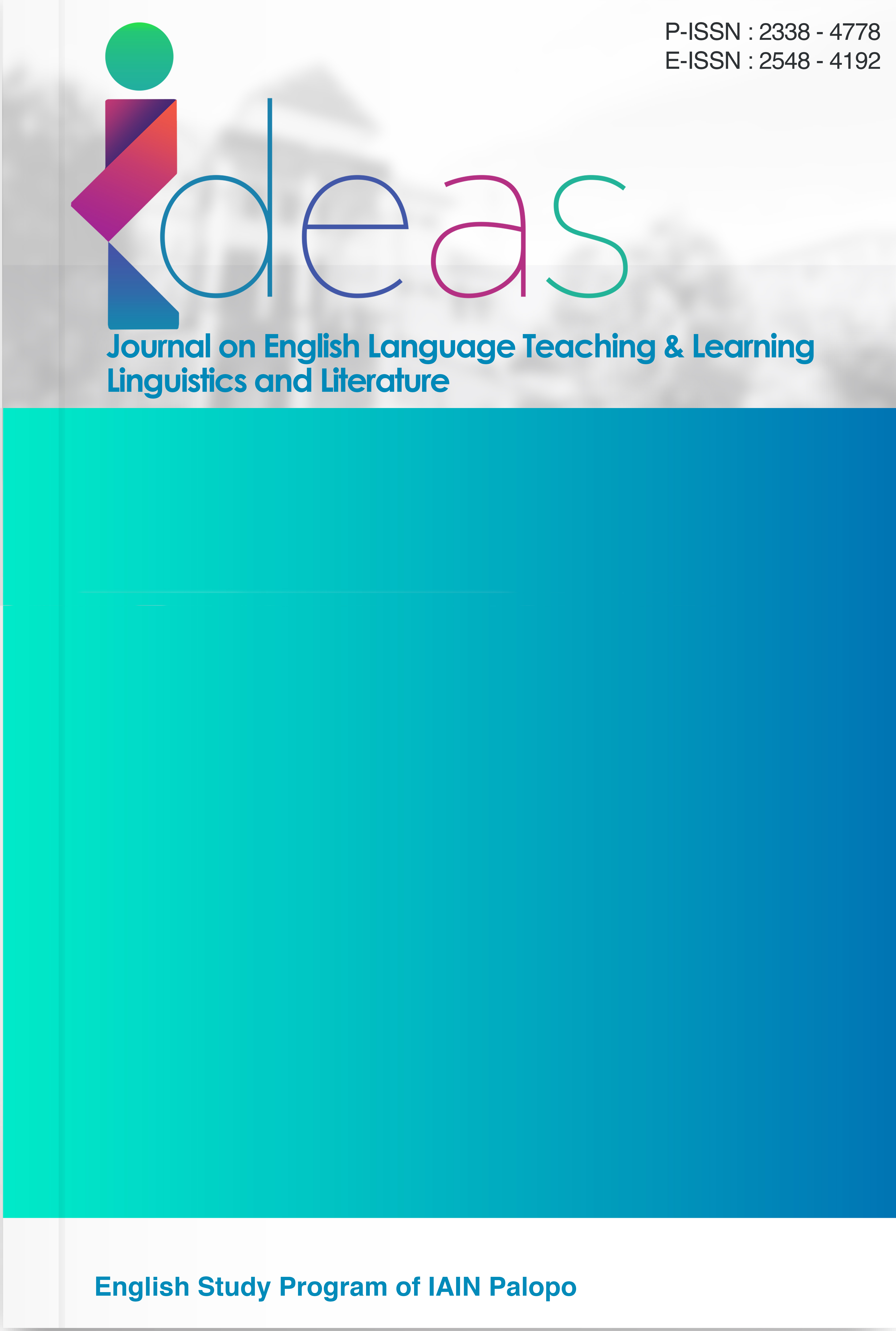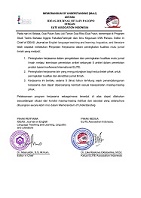Translating Arabic Literary Metaphors: A Comparative Evaluation of ChatGPT-4.0 and Google Translate 2024
DOI:
https://doi.org/10.24256/ideas.v13i2.7439Keywords:
Translating Arabic Literary Metaphors; Machine Translation Evaluation; Comparative AnalysisAbstract
This research conducted a comparative evaluation of ChatGPT-4.0 and Google Translate 2024 in translating Arabic literary metaphors into English. We applied a qualitative research approach focusing on the novel "Memory in the Flesh" by Ahlam Mosteghanemi, the study analyzed metaphor types 27 out of 77 data, translation strategies employed by each tool, and the quality of translations based on accuracy, acceptability, and readability. The study identified the types of metaphors used in the novel, analyzed the translation strategies employed by each tool based on (Newmark, 2022) framework, and evaluated the output quality using (Nababan et al., 2012, n.d.) assessment model of accuracy, acceptability, and readability. Findings indicated that while Google Translate 2024 showed a slight edge in literal accuracy which achieved 2.85, in acceptability Google Translate 2024 achieved 2.62 score and in readability achieved 2.31, ChatGPT-4.0 significantly outperformed it in acceptability and readability crucial for literary texts, In acceptability ChatGPT4.0 achieved 2.98 and in readability 2.99 score. The study highlighted the evolving capabilities of machine translation in handling nuanced literary language and underscores the continued importance of human oversight in achieving high-quality literary. The research emphasized Involving capabilities of neural machine translation systems, particularly in handling complex and nuanced literary content. However, it also underscored their limitations, especially in capturing cultural subtleties and maintaining the figurative resonance of literary metaphors. It underscored the continued necessity of human oversight to ensure fidelity and artistic integrity in literary translation, offering insights for translators, educators, and MT developers alike.
References
Adler, J. E. (1982). Metaphors We Live By. In Thinking: The Journal of Philosophy for Children (Vol. 4, Issue 1). https://doi.org/10.5840/thinking19824147
Aghazadeh, E., Fayyaz, M., & Yaghoobzadeh, Y. (2022). Metaphors in Pre-Trained Language Models: Probing and Generalization Across Datasets and Languages. Proceedings of the Annual Meeting of the Association for Computational Linguistics, 1, 2037–2050. https://doi.org/10.18653/v1/2022.acl-long.144
Al., I. et. (n.d.). Large Language Model Displays Emergent Ability to Interpret Novel Literary Metaphors Nicholas Ichien.
Ali Al Mubarak, A. (2017). The Challenges of Translating Idioms from Arabic into English A Closer look at Al Imam AL Mahdi University – Sudan. International Journal of Comparative Literature and Translation Studies, 5(1), 53. https://doi.org/10.7575/aiac.ijclts.v.5n.1p.53
Arenas, A. G., & Toral, A. (2022). Creativity in translation: machine translation as a constraint for literary texts. 1995, 1–31. https://doi.org/10.1075/ts.21025.gue
Austin, J., & Baker, M. (1993). In Other Words: A Coursebook on Translation. In The Modern Language Journal (Vol. 77, Issue 4). https://doi.org/10.2307/329719
Hassan, A., & Murshed, A. (2023). Rhetorical Influence of Figurative Language on the Meaning of Literary Texts. August. https://www.researchgate.net/publication/372855307
He, K., & Yun, H. (2017). On Translation Obstacles of Metaphorical Language. English Language and Literature Studies, 7(4), 104. https://doi.org/10.5539/ells.v7n4p104
Ismayanti, D., Said, Y. R., Usman, N., & Nur, M. I. (2024). The Students Ability in Translating Newspaper Headlines into English A Case Study. IDEAS: Journal on English Language Teaching and Learning, Linguistics and Literature, 12(1), 108-131.
Kövecses, Z. (2002). Metaphor :A Practicla Introduction.
Laszlóczki, L. (2022). Basil Hatim, Jeremy Munday (eds): Translation. An Advanced Resource Book. In Fordítástudomány (Vol. 24, Issue 2). https://doi.org/10.35924/fordtud.24.2.14
Lazar, G. (2015). Literature and language teaching. The Routledge Handbook of Language and Creativity, 2(June), 468–482. https://doi.org/10.1017/cbo9780511733048
Masruddin, M., & Nasriandi, N. (2022). Lexical and Syntactical Errors Performed by Junior High School Student in Writing Descriptive Text. IDEAS: Journal on English Language Teaching and Learning, Linguistics and Literature, 10(1), 1094-1100.
Nababan et al., 2012, P. 5. (n.d.). Google Translate impacts on Students’ translation of economic text: accuracy and acceptability. 6th ELTLT International Conference Proceedings, October, 487–491.
Nagao, M., Ikura, K., & Shirahata, S. (2003). JAACT volume: The Fourteenth Annual Meeting of the Japanese Association for Animal Cell Technology JAACT 2001: Preface. Cytotechnology, 40(1–3), 1. https://doi.org/10.1023/A:1023919116538
Newmark, P. (1988). (2022). Introduction to Translations. In Curator (Vol. 65, Issue 2). https://doi.org/10.1111/cura.12479
Nord, C. (2018). Translating as a purposeful activity: Functionalist approaches explained. In Translating as a Purposeful Activity 2nd Edition: Functionalist Approaches Explained. https://doi.org/10.4324/9781351189354
Owen, D., Attribution, C. C., License, U., Duff, A., Book, O. U. P. R., Studies, T., Studies, T., & Method, G. (2011). Review of Alan Duff ’ s " Translation " ( OUP / RBT ). 1989.
Roth, W. M. (2013). Translation in qualitative social research: The possible impossible. Forum Qualitative Sozialforschung, 14(2).
SaThierbach, K., Petrovic, S., Schilbach, S., Mayo, D. J., Perriches, T., Rundlet, E. J. E. J. E. J., Jeon, Y. E., Collins, L. N. L. N., Huber, F. M. F. M., Lin, D. D. H. D. H., Paduch, M., Koide, A., Lu, V. T., Fischer, J., Hurt, E., Koide, S., Kossiakoff, A. A., Hoelz, A., Hawryluk-gara, L. A., … Hoelz, A. (2015). Extended Conceptual Metaphor Theory. In Proceedings of the National Academy of Sciences (Vol. 3, Issue 1). http://dx.doi.org/10.1016/j.bpj.2015.06.056%0Ahttps://academic.oup.com/bioinformatics/article-abstract/34/13/2201/4852827%0Ainternal-pdf://semisupervised-3254828305/semisupervised.ppt%0Ahttp://dx.doi.org/10.1016/j.str.2013.02.005%0Ahttp://dx.doi.org/10.10
Simon, S. (2003). Gender in Translation. In Gender in Translation. https://doi.org/10.4324/9780203202890
Toolan, M. (2014). Language in Literature. Language in Literature, 1–250. https://doi.org/10.4324/9780203763537
Toral, A., & Way, A. (2018). What Level of Quality Can Neural Machine Translation Attain on Literary Text? 263–287. https://doi.org/10.1007/978-3-319-91241-7_12
Ullmann. (1962). Semantics. An Introduction to the Science of Meaning. The Modern Language Review, 58(1), 79. https://doi.org/10.2307/3720401
Venuti, L. (2008). The Translator ’s Invisibility Second Edition (Vol. 28, Issue 2).
Yan, C., & Huang, J. (2014). The Culture Turn in Translation Studies. October, 487–494.
Yang, L., & Min, Z. (2023). Statistical Machine Translation. Routledge Encyclopedia of Translation Technology, Second Edition, 40(August), 208–218. https://doi.org/10.4324/9781003168348-12
الجرجاني, ع. ا. ب. ع. ا. ب. م. (2008). دلائل الإعجاز (p. 711).
Downloads
Published
Issue
Section
Citation Check
License
Copyright (c) 2025 Ohod Faisal Ahmed, Ida Kusuma Dewi, Mohammed Yunus Anis

This work is licensed under a Creative Commons Attribution-ShareAlike 4.0 International License.
Authors retain copyright and grant the journal right of first publication with the work simultaneously licensed under an Attribution-ShareAlike 4.0 International (CC BY-SA 4.0) that allows others to share the work with an acknowledgement of the work's authorship and initial publication in this journal.
Authors are able to enter into separate, additional contractual arrangements for the non-exclusive distribution of the journal's published version of the work (e.g., post it to an institutional repository or publish it in a book), with an acknowledgement of its initial publication in this journal.
Authors are permitted and encouraged to post their work online (e.g., in institutional repositories or on their website) prior to and during the submission process, as it can lead to productive exchanges, as well as earlier and greater citation of published work (See the Effect of Open Access)




